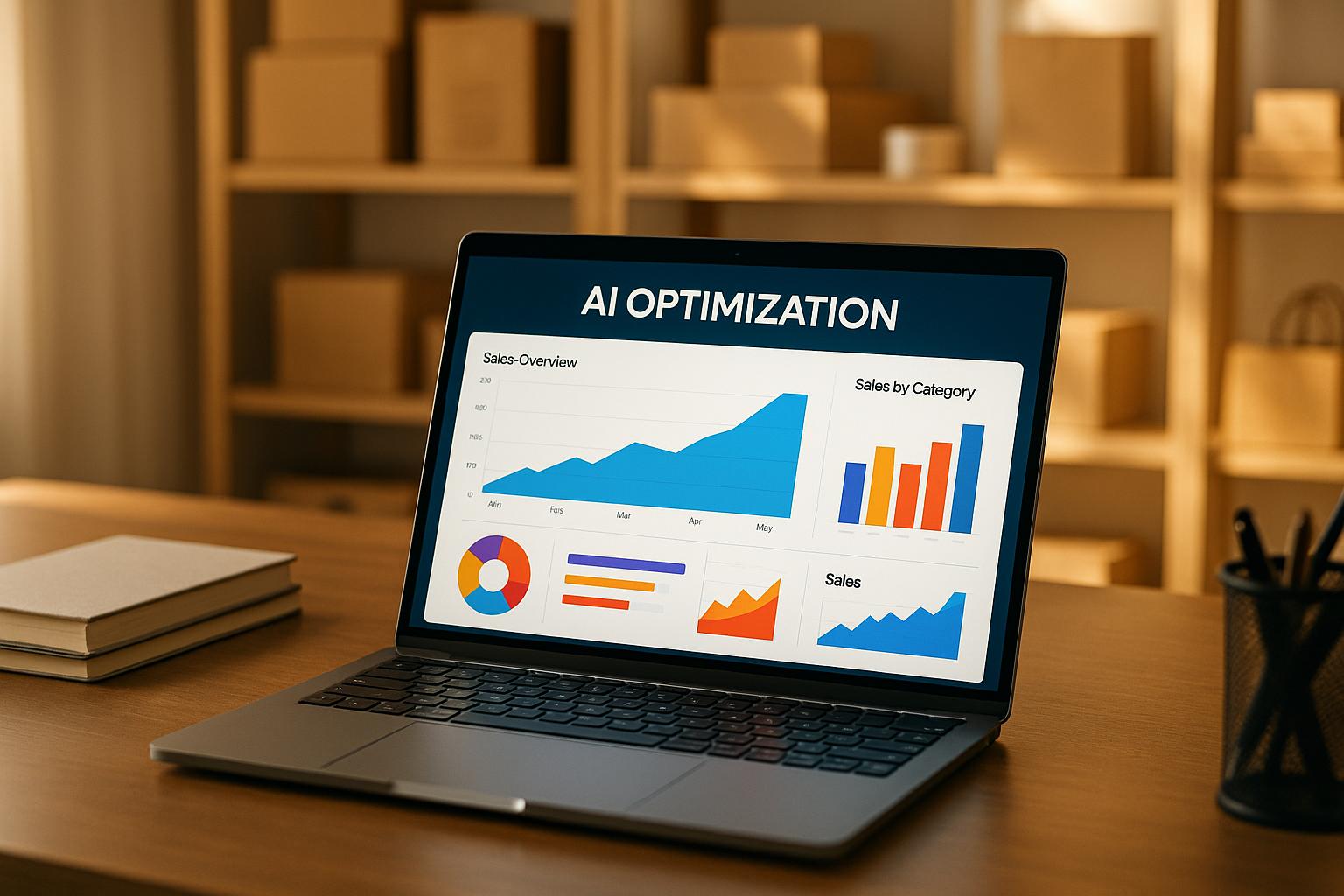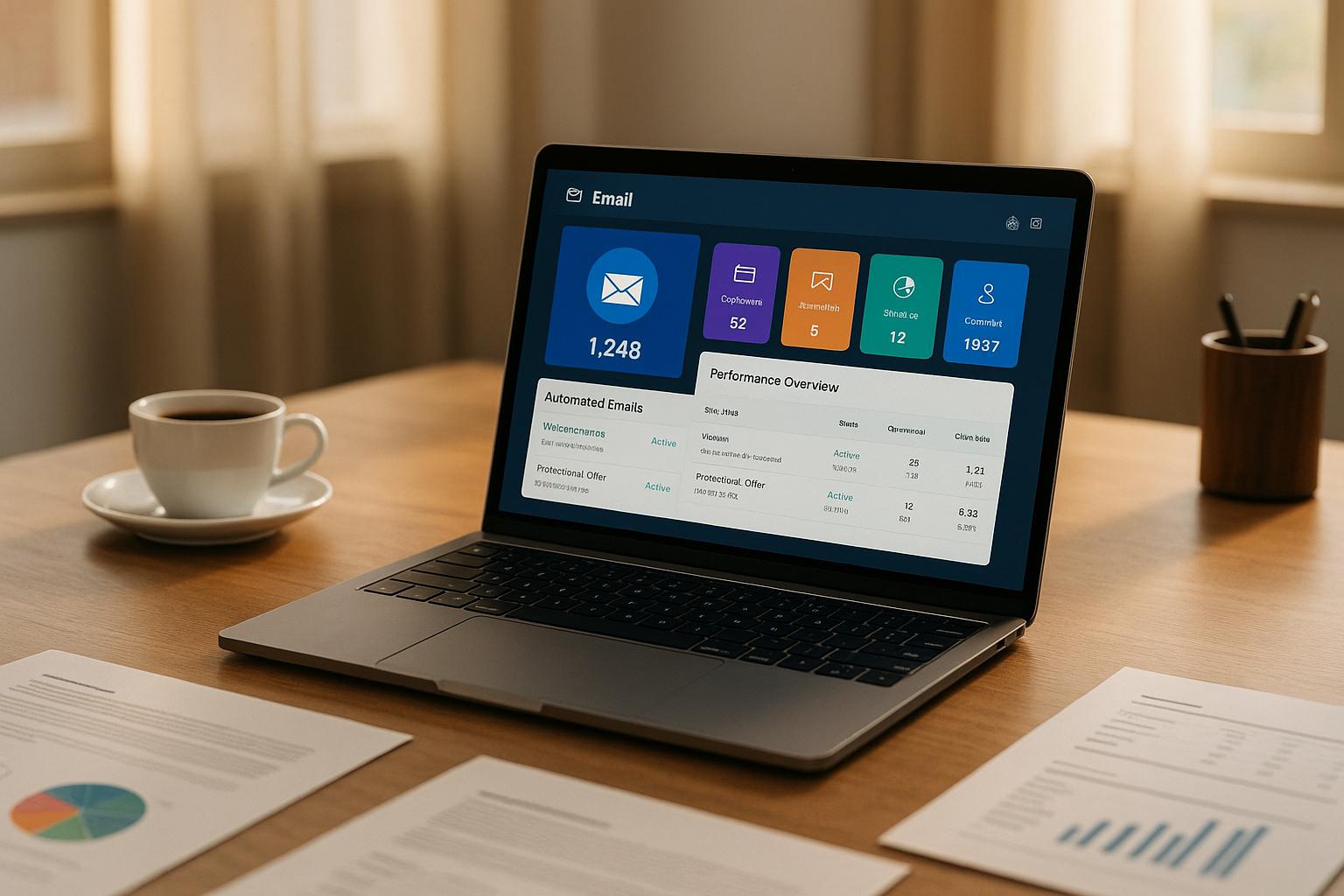By 2025, AI tools have made creating presentations faster and easier than ever. Whether you’re a business professional, educator, or creative, these tools can generate slides, refine designs, and even offer real-time collaboration. This article reviews 7 top AI presentation platforms to help you choose the one that fits your needs:
- Gamma: Generates polished presentations in minutes with advanced customization and collaboration tools.
- Presentations.AI: Focuses on team collaboration and brand consistency with features like Brand Sync.
- Beautiful.ai: Automates design tasks with Smart Slides and offers extensive templates for business use.
- Canva: A design favorite with its Magic Studio™ suite for brainstorming and polished layouts.
- Tome: Builds narrative-driven presentations from simple prompts, ideal for storytelling.
- Pitch: Combines sleek design, AI slide generation, and robust team collaboration.
- Prezi: Shifts from traditional slides to dynamic, non-linear storytelling with interactive visuals.
Each platform has unique strengths, from automation to branding tools. Below is a quick comparison to help you decide.
Best AI Presentation Maker (Compared ALL 21 tools)
Quick Comparison
| Tool | Key Feature | Best For | Starting Price |
|---|---|---|---|
| Gamma | Fast slide generation | Business professionals | Free (400 AI credits), Plus $10/month |
| Presentations.AI | Brand Sync for consistency | Teams needing collaboration | Free plan available |
| Beautiful.ai | Smart Slides for automation | Frequent business use | $12/month (annual plan) |
| Canva | Magic Studio™ for design | General design needs | Free and paid tiers |
| Tome | Story-driven presentations | Creative storytelling | Subscription-based |
| Pitch | Sleek design + collaboration | Team-based projects | Free plan, Pro $20/month |
| Prezi | Non-linear storytelling | Education & interactive use | Free plan available |
These tools cater to various needs, from quick data visualization to engaging storytelling. The right choice depends on your goals, whether it’s speed, branding, or collaboration.
1. Gamma
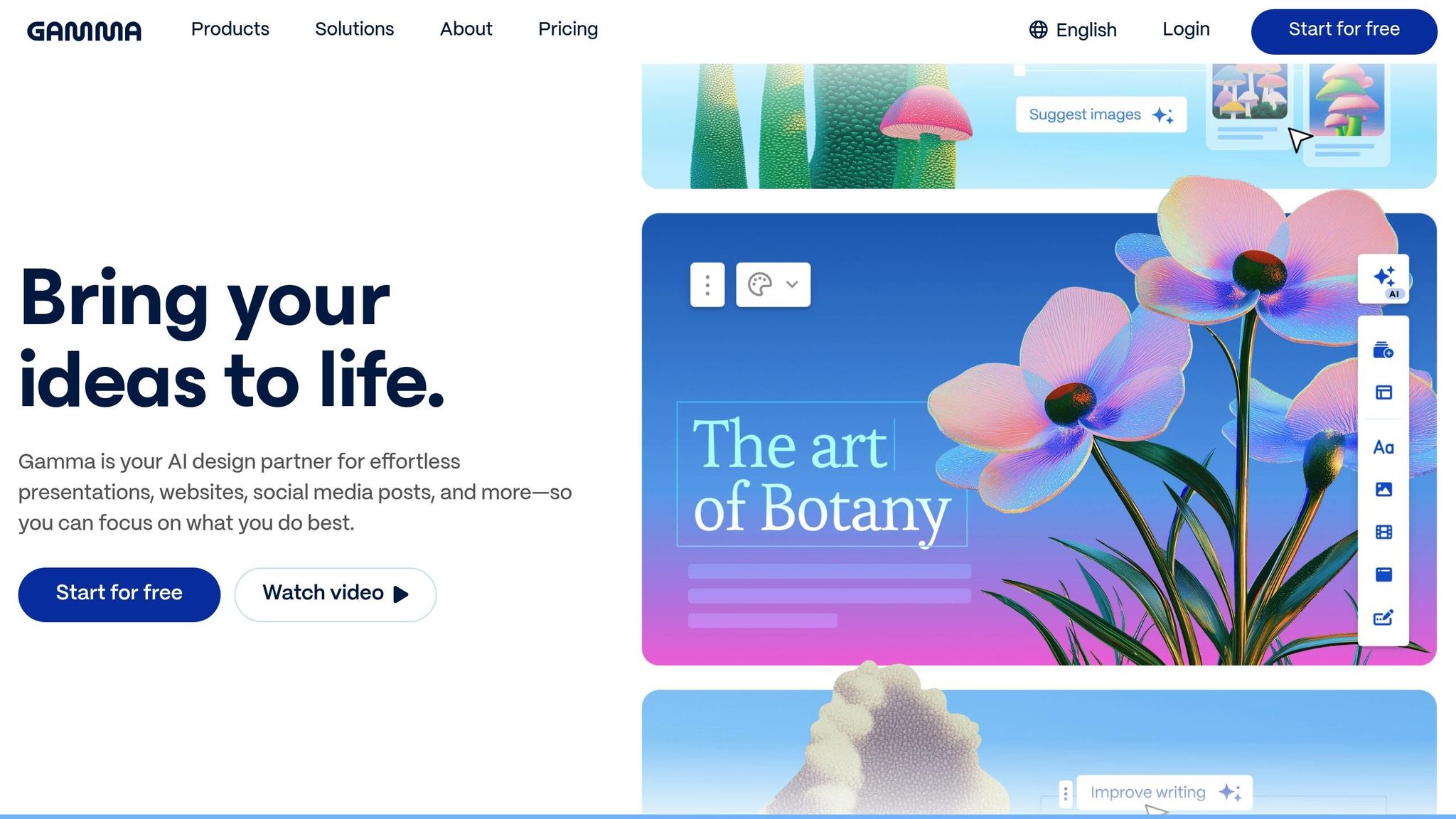
Gamma takes the hassle out of creating presentations, so you don’t need to be a design expert. Here’s a closer look at what it offers:
Gamma can auto-generate fully polished presentations in just a few minutes. Whether you start with a brief prompt, disorganized notes, or carefully selected content, Gamma can handle it. Plus, with support for over 60 languages, it’s a practical tool for global teams and businesses operating across different regions.
Need speed? Gamma delivers. It produces complete presentations in two minutes, wrapping up the entire process in about three minutes.
Its wide range of templates, automated typesetting, and dynamic text adjustments ensure your slides look professional. You can also customize themes, incorporate AI-generated or personal images, and tweak the tone to align with your brand identity.
Collaboration is seamless with Gamma’s cloud-based editing, which supports real-time teamwork. You can also download presentations for offline use and share them easily with your team. Additional AI-powered tools like AI Chat, image editing, and image generation expand its capabilities even further.
For users looking for advanced functionality, Gamma’s Generate API (currently in beta) allows programmatic content creation. It integrates with tools like Make, Zapier, Workato, and N8N, offering Pro and Ultra users up to 50 content generations per hour.
Another standout feature? Gamma can transform imported files into sleek presentations by summarizing content, auto-generating catalogs, and crafting copy. It’s a quick way to turn reports or other documents into visually engaging presentations.
2. Presentations.AI
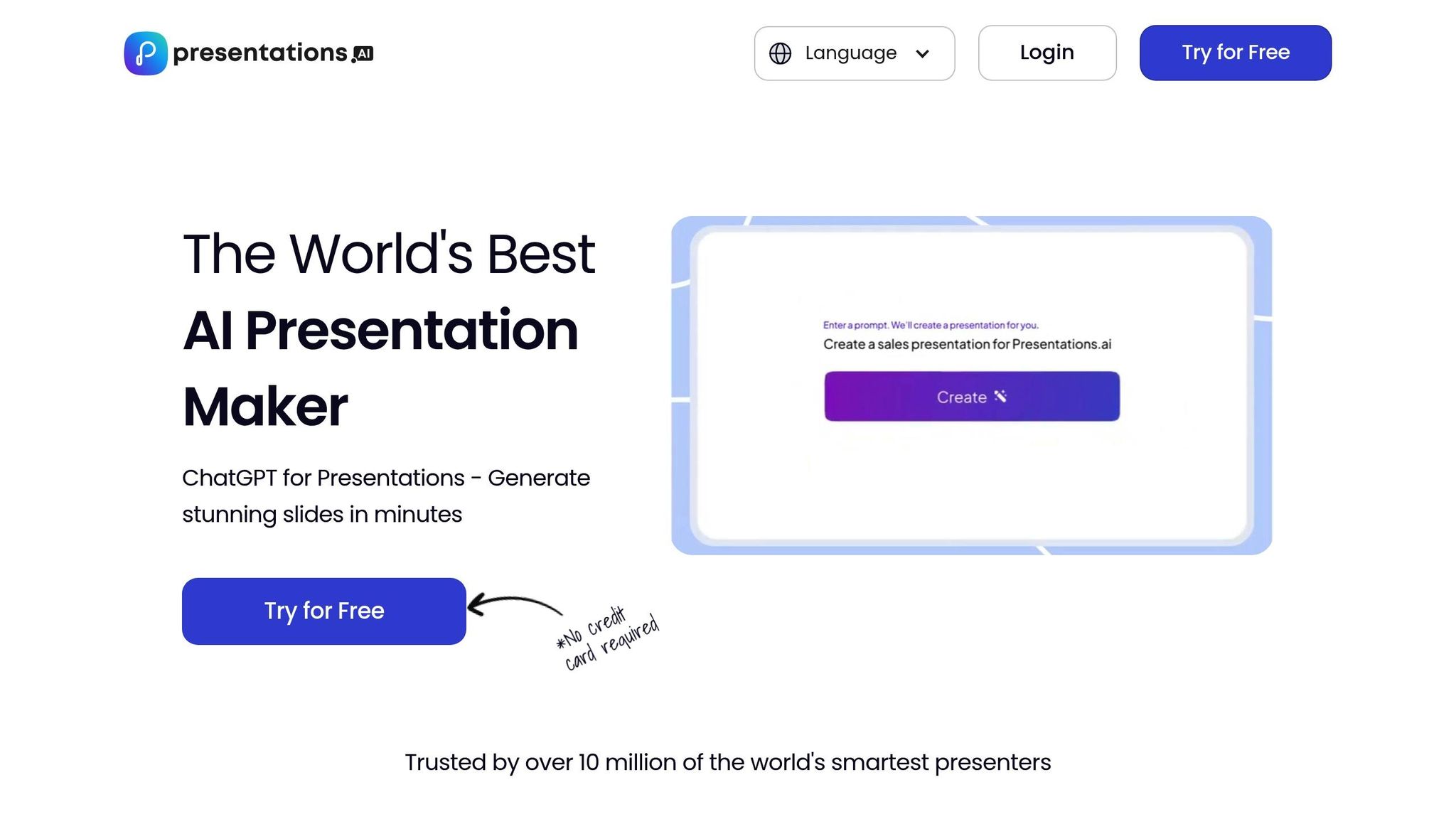
Presentations.AI simplifies the process of creating team presentations by combining smart automation with smooth workflow integration. Similar to Gamma, it focuses on improving team collaboration and maintaining brand consistency. However, it also brings its own set of features that make creating presentations a more collaborative and brand-focused experience.
A key highlight is the Brand Sync feature, which ensures every presentation aligns with your brand's visual identity automatically. This eliminates the hassle of manually adjusting designs to match branding guidelines.
Collaboration is another core strength of this platform. It offers real-time editing with advanced access controls, so teams can easily manage who can view or edit a presentation. The real-time synchronization feature ensures everyone stays updated without dealing with version conflicts, making teamwork more efficient and seamless.
The platform also includes an intuitive chat interface, allowing users to guide the AI using conversational commands. This makes it accessible to everyone, regardless of their technical skills. Adaptive templates further enhance the experience by maintaining professional design quality even as content evolves. Plus, its multi-device compatibility means you can edit and present from virtually anywhere - ideal for today’s flexible work setups.
For added insights, Presentations.AI offers embedded analytics that track audience engagement, helping teams fine-tune their presentations based on real data. And when it’s time to share or present, export options ensure compatibility with PowerPoint, keeping workflows smooth and uninterrupted.
3. Beautiful.ai
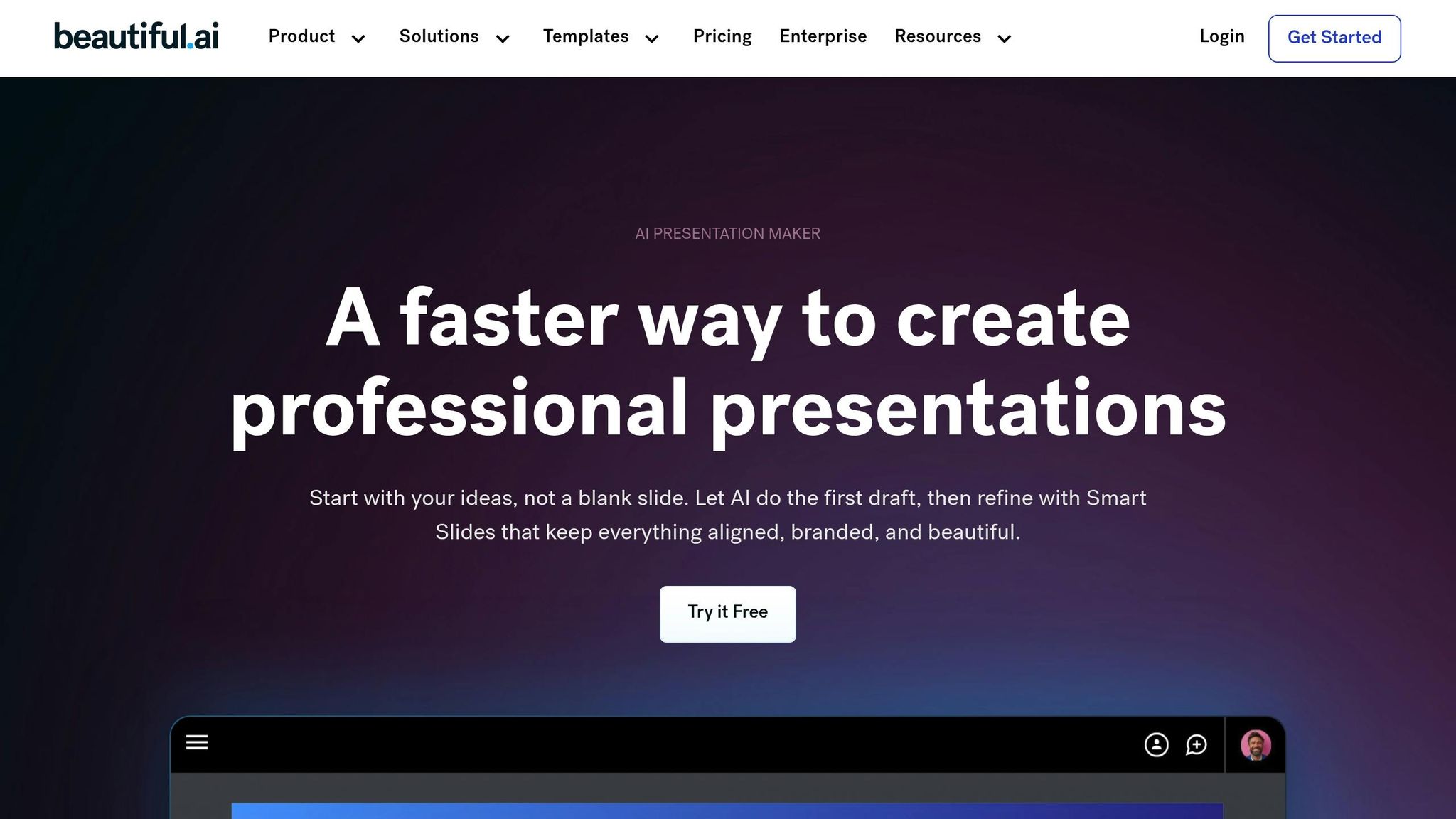
Beautiful.ai takes a different approach by focusing on removing the typical design headaches that come with creating presentations. It uses intelligent automation to handle all the tedious formatting tasks - like adjusting layouts, spacing, fonts, colors, and even chart styles - so users can focus entirely on their content. The platform's Smart Slides technology ensures that design elements automatically adapt as you make changes, saving time and effort.
Its library of AI-powered templates is tailored for various business needs, including pitch decks, quarterly business reviews, marketing presentations, and lectures. These templates are not only dynamic but also allow for extensive theme customization, giving users the flexibility to align presentations with their branding.
Beautiful.ai also makes managing visual assets a breeze. Users can upload logos, photos, and videos to maintain brand consistency or choose from the platform's stock library to enhance their presentations.
Collaboration features are another strong point. The Locked Slides feature ensures that critical information stays protected by restricting editing access to approved team members. This helps maintain brand consistency and data accuracy across shared decks. The platform integrates seamlessly with tools like Dropbox, Slack, Monday.com, Salesforce, and Webex. It also offers export options to PowerPoint (PPT, PPTX) and Google Slides, making it easy to share and edit presentations across different platforms.
"We reduced time by 75%, our teams now focus on core message, story, and content - not the design." – McNeel Keenan, VP of Product Management, CVENT
Pricing for Beautiful.ai starts at $12 per month when billed annually. All plans include unlimited access to Smart Slide templates and a wide range of ready-to-use presentation designs.
"Beautiful.ai is a game changer for creating beautiful, engaging learning content at unheard of speed. Their smart templates and AI assist tools have helped us to create some of the most amazing stuff we've ever put out." – Ryan Heinl, Executive Director, Wake Forest University
This platform is especially valuable for users who need to create presentations frequently but don’t have a background in design. By automating the technical aspects and delivering polished, professional results, Beautiful.ai strikes a perfect balance between simple AI tools and costly design services.
4. Canva
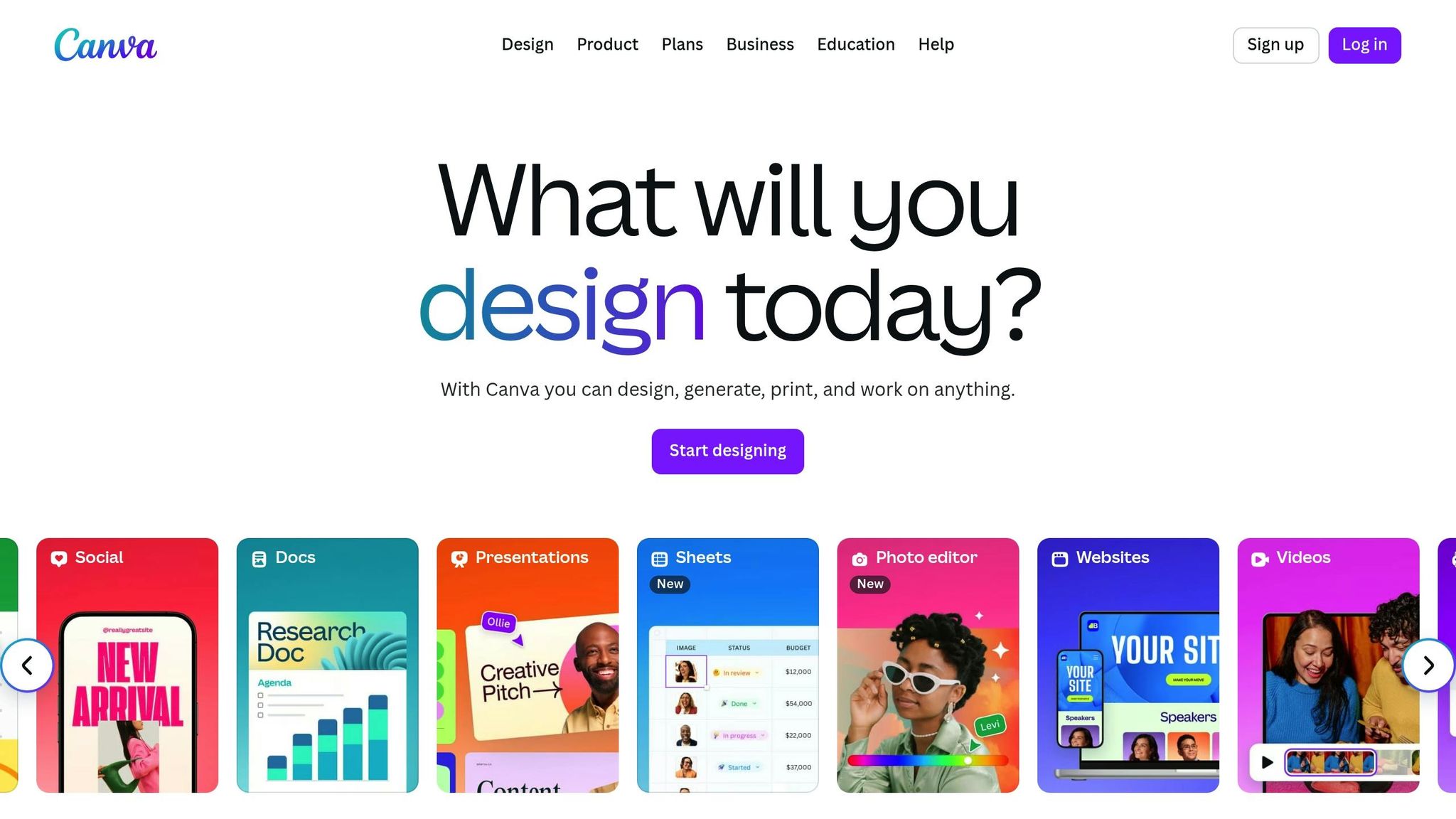
Canva offers a fresh take on AI-powered presentation design. Known as a go-to platform for all things design, Canva has introduced its Magic Studio™ suite, which simplifies the process of creating professional presentations. With Magic Studio™, users can brainstorm ideas, fine-tune layouts, and craft visually appealing slides that maintain a polished and consistent style throughout. It's a smart, user-friendly tool that elevates the presentation-making experience.
sbb-itb-212c9ea
5. Tome
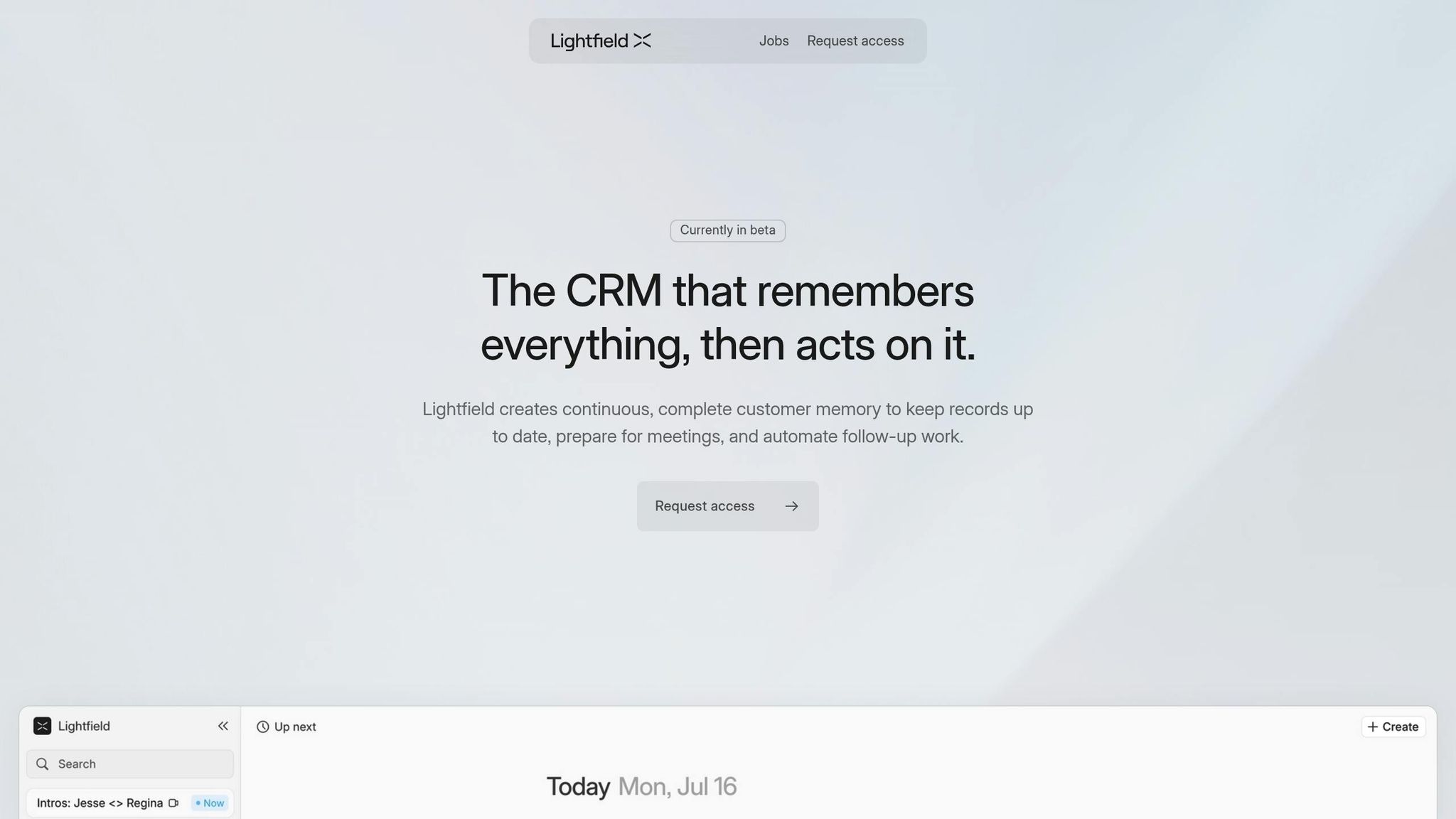
Tome is an AI-driven storytelling platform that reimagines how presentations are created. Instead of starting with blank slides, it crafts narratives from simple prompts, making it a lifesaver for anyone who finds content creation challenging or needs to produce presentations in a pinch.
All you have to do is input a topic or a brief, and Tome generates a well-structured presentation. It doesn't just spit out bullet points - it builds a cohesive narrative with clear text, suggested visuals, and a logical flow. The result? Presentations that feel natural, engaging, and far from generic.
What sets Tome apart is its focus on storytelling. Unlike traditional presentation tools, its templates are designed around narrative-driven formats rather than standard business layouts. Whether you’re preparing for a product launch, delivering company updates, creating educational material, or pitching a creative idea, Tome has templates tailored to help you keep your audience hooked from start to finish.
The platform also provides real-time editing, commenting, and version history. Teams can collaborate seamlessly - adding comments, suggesting edits, and tracking changes as they go. While the AI takes care of the heavy lifting by generating the initial content, users retain full control to tweak text, adjust layouts, and add their own branding. Tome supports a variety of media types, including images, videos, and interactive elements, allowing you to enhance your story in ways that truly resonate with your audience.
Another standout feature is its mobile-responsive design. Presentations automatically adapt to different devices, making it ideal for remote meetings or sharing content with viewers on tablets or smartphones.
Tome also integrates with popular business tools, making it easy to import data and export presentations without disrupting your existing workflow. This seamless integration ensures that Tome fits right into your process, saving you time while delivering polished, professional results.
6. Pitch
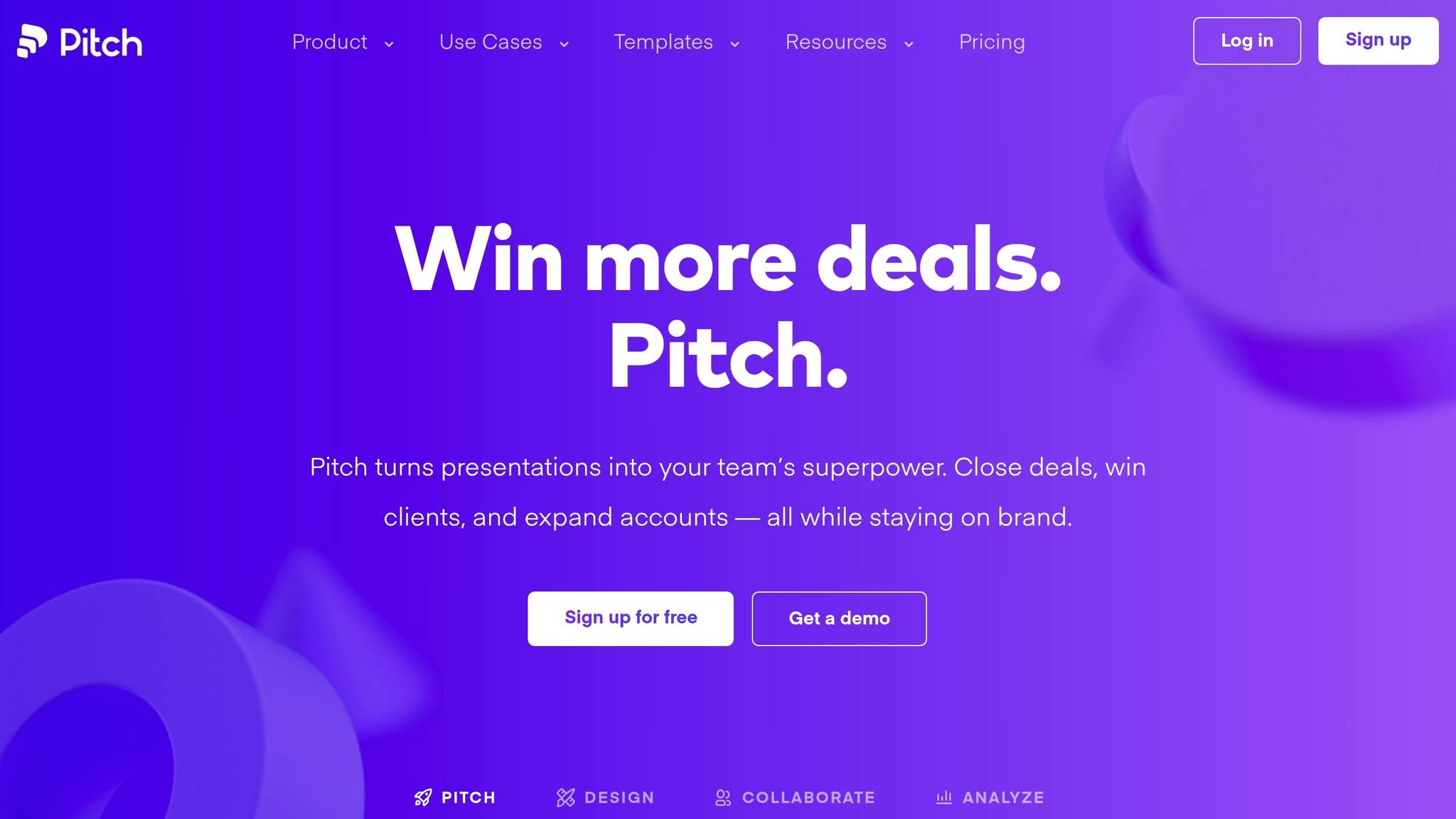
Pitch takes presentation creation to a whole new level, blending AI-driven tools with sleek design and seamless collaboration. At its core is the "Start with AI" feature, which eliminates the dread of staring at a blank slide. With just a 400-character prompt, Pitch generates a structured outline complete with slide ideas, giving you a solid starting point while leaving plenty of room for your personal touch.
Beyond its AI capabilities, Pitch offers a rich library of over 100 professionally designed templates tailored to various industries and scenarios. Whether you're crafting a pitch deck, leading a team meeting, or preparing a board presentation, there's a template that fits. Additionally, the platform provides nearly 100 slide layouts, including timelines, image grids, diagrams, and quotes, all designed to integrate effortlessly with your chosen style.
One of Pitch's standout features is its commitment to brand consistency. Users can upload custom fonts, manage brand assets like logos and images, and create slide styles featuring their brand colors. These tools are stored in a shared library, making it easy for teams to maintain a unified look across all presentations.
"I can create my style guide with custom fonts, and edit templates quickly and way more effectively than with PowerPoint or Keynote." - Brando Vasquez, Branding and Design Lead
Pitch’s pricing is designed to accommodate teams of various sizes. The Free plan supports up to 5 team members, offering access to the AI Presentation Maker, unlimited presentations, and custom templates. For more advanced features, the Pro plan is available at $20 per month or $204 annually for two editors. This plan includes presentation analytics, unbranded exports, and version history, with additional editors costing $156 per year each (up to 25 users).
The platform also integrates smoothly with existing workflows. It supports imports from PowerPoint, Keynote, and Google Slides, and allows exports to PowerPoint or PDF formats. This flexibility ensures teams can adopt Pitch without disrupting their current processes.
Often referred to as the "Instagram of presentations", Pitch has gained a reputation for its focus on visually stunning, design-forward pitch decks that balance aesthetics with functionality.
7. Prezi
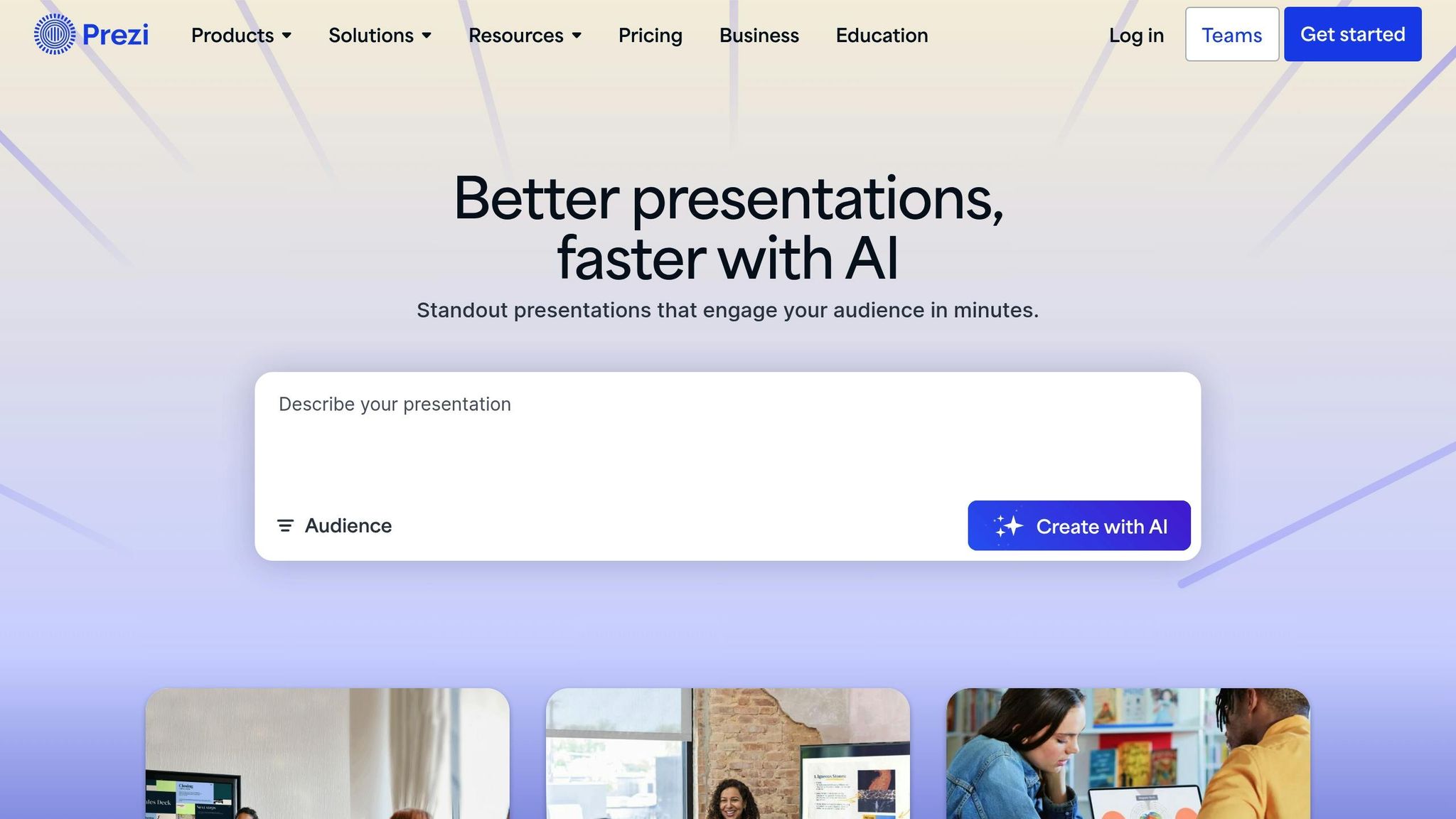
Prezi has reimagined how presentations are designed, moving away from the standard slide-by-slide approach to offer dynamic, non-linear storytelling. Over time, its AI capabilities have grown, shifting from a template-dependent system to a more adaptable, element-focused design that gives users greater creative control.
The platform’s AI-driven content generation begins with a simple prompt of at least six words, supporting any language compatible with OpenAI. It can also take uploaded files like PPTX, PDF, or DOCX and transform them into entirely new presentations. By restructuring and redesigning the content, Prezi adapts the material to its signature visual storytelling style. These advancements highlight Prezi's ongoing evolution in offering personalized and interactive presentation tools.
"Prezi AI will help you create designs tailored to your content. Prezi AI will suggest the best solution to achieve the best results." - Prezi
By late 2024, Prezi AI transitioned from its earlier template-based model to a more dynamic, template-free system. While users can still access professionally designed templates in categories like General, Business, Education, and Timeline, the platform now focuses on building presentations around customizable elements and visual metaphors.
Throughout 2025, Prezi introduced several updates to enhance user experience. The AI sidebar now allows users to generate custom color palettes and designs. Updates between April and May 2025 added features like adjustable line height, letter spacing, an expanded shape library, and AI-suggested font styles. Later in August 2025, a logo-guided palette generation feature was introduced.
Visual tools have also seen significant improvements. Users can now access features such as background removal, opacity adjustments, filters, overlays, and rounded corners with drop shadows (June 2025). Flexible frame editing and AI-suggested images further simplify layout adjustments, making it easier to create polished, professional designs.
"Prezi stands out with its AI-driven design capabilities, allowing users to create presentations that are not only visually stunning but also highly interactive. This innovative approach to presentation design sets it apart, offering a fresh alternative to static slide decks." - Futurepedia.io
Studies back up Prezi’s effectiveness: an independent university study found that Prezi is 25% more effective than traditional slides and 40% more memorable compared to PowerPoint. User feedback aligns with these findings, as Prezi boasts a 4.6/5 rating from over 2,000 reviews. Futurepedia.io also rates Prezi AI highly, giving it a 4.4/5 overall score, including a 4.6/5 rating for Customization and Flexibility. These accolades have cemented Prezi’s reputation as a leader in creating engaging and attention-grabbing presentations across various industries.
That said, Prezi AI has faced criticism for its limited customization options, which can sometimes hinder users looking for highly personalized designs. Still, its fresh take on visual storytelling continues to draw users eager to create presentations that stand out from the typical slide deck format.
Pros and Cons
The detailed reviews above provide a solid foundation for understanding the strengths and weaknesses of each tool. Here's a closer look at their key highlights and challenges.
Time Savings
AI-driven tools can drastically cut down on the time spent creating content and visuals, allowing you to focus on perfecting your message. However, the quality of what these platforms produce can differ greatly. Some excel in automating design, while others are better at generating written content.
Collaboration Capabilities
Collaboration tools are a must in today’s remote and hybrid work setups. Platforms like Pitch, Beautiful.ai, Gamma, Presentations.AI, and Canva offer various features for teamwork, including real-time editing, easy sharing, and version control. Each platform has its strengths in this area, catering to different collaboration needs.
Template Variety and Customization
The range and flexibility of templates are major factors in choosing a platform. Beautiful.ai impresses with its extensive library and Smart Templates that adapt layouts to your content. Canva offers a vast selection of templates and AI-powered suggestions for design elements like colors and fonts. Pitch provides a mix of flashy and functional slide types, while Prezi stands out with its dynamic and innovative frame layouts. In contrast, Presentations.AI offers a more limited selection of 13 templates. Tome takes a unique approach, focusing on story-driven designs with dark backgrounds and bold visuals, though its template options are more narrow.
Branding and Customization Options
Branding tools vary widely across platforms. Beautiful.ai shines with its Smart Slides, which maintain consistent design and enforce brand guidelines. Pitch allows for customization with personal brand colors, fonts, and templates, plus branded exports. Presentations.AI features Brand Sync, which applies corporate branding automatically. Gamma, on its Pro plans, supports theme and font customization.
| Tool | AI Content Generation | Template Variety | Collaboration | Branding Options | Starting Price |
|---|---|---|---|---|---|
| Gamma | Strong card-based layouts | Flexible, AI-driven designs | Collaborative editing | Custom themes on Pro plans | Free (400 AI credits), Plus $10/month |
| Presentations.AI | Basic content generation | Limited (13 templates) | Team features on free plan | Brand Sync feature | Free plan available |
| Beautiful.ai | Smart Templates with auto-adjustment | Large template library | Robust team collaboration | Excellent brand governance | Professional plans |
| Canva | AI suggestions for design elements | Extensive variety | Team collaboration tools | Custom brand kits | Free and paid tiers |
| Tome | Story-driven structure | Specific dark/colorful style | Standard sharing | Limited customization | Subscription-based |
| Pitch | Content automation | Wide variety, flashy designs | Real-time collaboration | Custom brand colors/fonts | Professional plans |
| Prezi | Dynamic, non-linear design | Innovative templates | Standard collaboration | Template customization | Free plan available |
Advanced AI Features and Usability
Features like AI-driven image generation and content suggestions add depth to these platforms. However, some tools prioritize functionality over simplicity, making usability a balancing act between powerful AI capabilities and intuitive design tools.
Pricing Considerations
Pricing structures vary significantly. For instance, Gamma provides 400 AI credits for free, with a Plus plan available at $10/month. Prezi also offers a free plan, making it accessible for those on a budget.
Customization Limitations and Learning Curves
One common drawback is limited flexibility for highly personalized designs. While AI automation speeds up the process, it can restrict creativity by locking users into preset design frameworks. Additionally, learning curves differ across platforms. Tools like Beautiful.ai and Canva are easier to pick up due to their template-heavy approach, while more unconventional platforms like Prezi (non-linear storytelling) or Tome (narrative-focused designs) may take extra time to master.
Conclusion
Choosing the right AI presentation tool depends heavily on your specific needs and workflow. For business teams aiming to create polished, data-driven presentations, Beautiful.ai stands out with its smart templates and detailed brand customization options. Similarly, Pitch offers excellent real-time collaboration features, making it a strong choice for team-based projects.
Educators and academic users might gravitate toward Prezi, which excels with its engaging visual flow and non-linear presentation style - perfect for classroom dynamics. Meanwhile, Gamma provides advanced customization, like audience targeting and tone adjustments, allowing educators to tailor content for diverse student groups. For creative professionals, Canva shines with its clean visual editing tools and comprehensive brand kit features, ensuring presentations look both professional and unique. Many of these tools also offer free plans, making them accessible even within tight educational budgets.
AI-driven automation significantly speeds up the creation process by generating slide outlines, content, visuals, and design elements in minutes. This efficiency is reflected in the pricing, which ranges from Gamma's free plan (including 400 AI credits) to affordable professional tiers across all platforms. While these tools may not fully replace professional designers for critical, high-stakes projects, they are ideal for everyday business, academic, and internal use cases.
A balance between automation and customization is becoming the norm. Gamma combines automatic slide generation with detailed audience and content controls, while Beautiful.ai pairs AI-powered content creation with robust brand customization tools.
As the AI presentation landscape continues to evolve, staying informed about new tools and features will be crucial. For the latest reviews and updates on emerging technologies, visit AIapps.com - your go-to source for discovering cutting-edge AI tools.
FAQs
How can AI tools make team collaboration on presentations easier?
AI-driven presentation tools make teamwork easier by enabling real-time editing and shared access to slides. This means team members can work on the same project at the same time, eliminating endless back-and-forth revisions and speeding up the process.
Many of these tools also come with features like automated design tips and content arrangement. These not only save time but also help the team create a well-organized, professional-looking presentation without much hassle. Everyone stays aligned, and the workflow becomes much smoother.
What should I look for when selecting an AI tool for creating presentations?
When choosing an AI tool for creating presentations, there are a few key factors to keep in mind to make sure it aligns with your needs. First, compatibility is crucial - ensure the tool integrates smoothly with platforms you already use, like PowerPoint or Google Slides. This avoids unnecessary headaches and keeps your workflow intact.
Next, pay attention to content quality. The AI should produce slides that are clear, relevant, and visually well-structured. A tool that delivers polished content right out of the gate can save you a lot of time.
It's also worth considering tools that offer customizable designs and polished layouts. These features can elevate the overall look of your presentations, making them more engaging and professional. Along with that, prioritize ease of use - a tool that simplifies the editing process can be a game-changer, especially when you're short on time.
Finally, check for standout features like AI-driven storytelling, smart templates, or automated formatting. These extras can streamline your work and make creating impressive presentations quicker and more efficient.
How do AI presentation tools ensure automation doesn't compromise brand customization?
AI presentation tools expertly combine automation with the flexibility of brand customization. They typically include features like editable themes, colors, fonts, and logos. Many even allow users to set up a brand profile, where elements such as company colors and typography are stored. This ensures every slide reflects the company’s identity.
This blend of automation and personalization not only keeps branding consistent but also simplifies the design process - even when working with imported files like PDFs or PowerPoint presentations. By handling repetitive tasks while still allowing for fine-tuned adjustments, these tools help save time without compromising on quality or professionalism.
